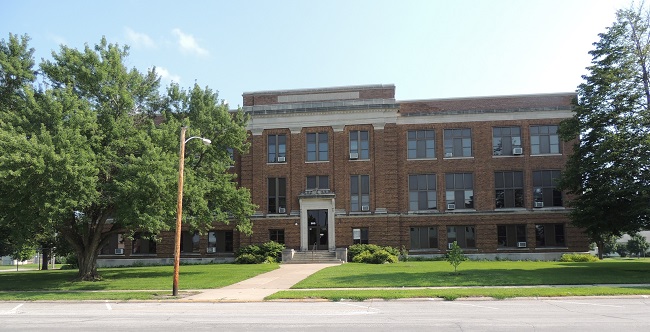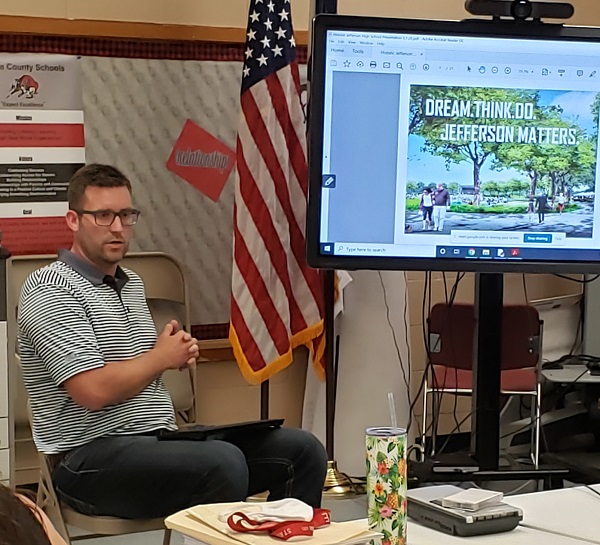The future of Greene County’s 1921 school building and the attached 1952 gymnasium was the topic of discussion at the school board’s work session July 15.
The three-story classroom portion of the building has seen its last students. Middle school students are moving from the vintage building to the repurposed 1966 building, which until now has been the high school.

High school students will start the school year in the new $35.48 million school and regional career academy, which also features a much larger gymnasium and a 700-seat auditorium.
The Greene County district has razed parts of three vintage buildings in recent years. The Jefferson-Scranton district razed the classroom portion of the Scranton building in 2012. After the reorganization of J-S and East Greene Schools, the classroom portion of the Rippey building was razed in 2015. The entire Grand Junction building was razed last summer.
The classroom portion of the Jefferson building will most likely have a gentler fate. Nate Adams, a Carroll County native who works for Principal Real Estate Investors in Des Moines, has been working with Greene County Development Corporation for more than a year, planning to repurpose the building into 25 1-, 2-, and 3-bedroom apartments. He shared his ideas with the school board last week.

The apartment complex would be part of the “Three Block Project” proposed in Jefferson’s Vision 2020 plan. That proposal includes the Greene County Community Center and the double block that includes the middle school and the Greene County Early Learning Center/Greene County Schools administration building. It includes what Adams called a “centerpiece park,” with plenty of trees and grass, perhaps a splash pad or permanent amphitheater seating, but no gymnasium.
He said his proposal for the reno of the middle school fits a need for rural revival and would be an example for the rest of the state as “a well done, effective re-use of an old building.”
He is applying for federal and state historic tax credits and funds through the Iowa Economic Development Authority. He told the board he’s still working on the budget, but if all goes as planned, construction would start next June and leasing of the apartments would begin in April 2022.
The gymnasium isn’t part of the Three Block Project and it isn’t part of Adams plan. He told the school board that he couldn’t develop a “sustainable” use for the gym. The gym was built in 1952 and isn’t eligible for historic tax credits.

It’s connected to the school by a hallway and both are on the same heating/ventilation system. Adams estimated that putting HVAC in the gym standing alone would cost $350,000. He said the gym would need a new roof in the next few years at a cost of about $200,000, and that it would cost $50-100,000 to bring the building into ADA compliance. He said he could see it costing $750,000 in the next 5-7 years to maintain the gym. He would have no qualms about it being torn down.
School superintendent Tim Christensen dodged a direct question about the financial arrangement with Adams should he take possession of the school. He answered, “We know what it costs to tear down a school.”
According to Adams, he’d be “taking a problem off the community’s hands.”
Jeramie Hinote, coach/owner of Play4Him Academy LLC, also talked with the board. He’d like to see the gym kept for its intended purpose, and he’d like to take ownership of it.

He said there are currently 16 basketball teams in the academy with 140 players. He draws players from 84 school districts. He rents gym space wherever he can, including at the Greene County Community Center and the Scranton Community Center. He hosts basketball tournaments on weekends; a tournament Play4Him hosted in Carroll drew 900 players and their families.
“Youth sports is a growing industry. It’s not going away,” Hinote said.
Christensen was planning a public meeting about the future of the gym before the pandemic. Hinote, though, said he hasn’t developed a business plan for the building and he hasn’t explored financing options. He said he knows there are corporations and organizations that support youth athletics.
“I came to you guys first to let you know what I could do with the building and for our kids,” he said.
The board asked Hinote to return with a financial plan that includes projections showing the venture would be sustainable for many years.
Adams said he’d be open to the idea of the gym remaining, separated from the three-story building, “but I don’t like it.”
